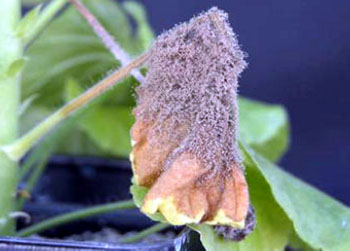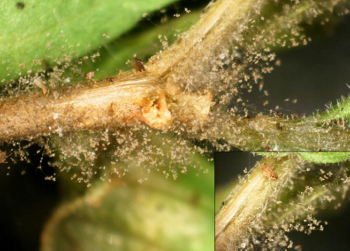Botrytis blight outbreaks expected in greenhouses due to weather
Forecasts for clouds and rain favor Botrytis blight. Cultural practices and correct fungicides will help until the sun shines.

The forecast for the next five days indicates cloudy, cool and rainy weather conditions. These low light, humid conditions combined with many of our greenhouse floral crops being at or near full flower in area greenhouses can lead to Botrytis blight outbreaks. Crops like geraniums, Gerbera daisy, petunias, fuschia and calibrachoa, to name a few, can be especially vulnerable to this disease now since they have a full flower canopy and most greenhouses are soon to be filled to the maximum allowable space.
Remember that Botrytis is a fungal disease that can cause leaf spots, petiole blighting and stem cankers (Photo 1) on many different annuals and perennials. It will produce large masses of “fuzzy looking” spores (Photos 2- 3) that are most often called “gray mold.” These spores or conidia will be spread on wind currents and can readily travel from infected to uninfected plants in that manner. The spores can survive for upwards of 21 to 24 days before they germinate on a plant.


Photos 2-3. Left, Sporulation and blighting caused by Botrytis. Right, Botrytis sporulation close-up. Photo credits: Photo credit: Mary Hausbeck, MSU (Left) and Tom Creswell, Purdue University (Right)
Michigan State University Extension suggests the following cultural control practices that will reduce the conditions that favor Botrytis infections: reducing the relative humidity in the greenhouse below 85 percent; making sure plants do not remain wet for six or more hours in a 24-hour period; and if possible, heat and vent on mornings and evenings for at least a half-hour or more to reduce humidity thus removing the humid, warm air allowing for plant surfaces to dry.
If plants are seriously infected and need to be removed from the growing area, do not just remove the plants and throw them on the compost pile out behind your greenhouse range as the spores can blow back into the facilities on wind currents. Instead, bag up infested plants where they were growing, seal the bags and remove them from the facilities, thus reducing the risk of spores dislodging and infecting other plants in the greenhouse. This process should also be used when cleaning plants to remove dead foliage. Bag it and remove the spent blooms or leaves as quick as possible so the spores are not released in a clean greenhouse.
As for preventative fungicides, MSU plant pathologist Mary Hausbeck recommends the following fungicides that contain these active ingredients: chlorothalonil, fenhexamid, iprodione, pyraclostrobin + boscalid, cyprodinil +fludioxonil or polyoxin D zinc salt. These suggestions are based on years of trials conducted by Hausbeck and her staff.
Apply any of the above mentioned products as foliar sprays and be sure to have complete coverage, and do not go longer than seven days between applications for best results. Some of the above products may “spot” open flowers or leave a residue. Be sure to read the label for specific recommendations and warnings for the product you chose to use.
For additional information on this topic or any other commercial greenhouse issues, contact your area MSU Extension floriculture educator.



 Print
Print Email
Email


